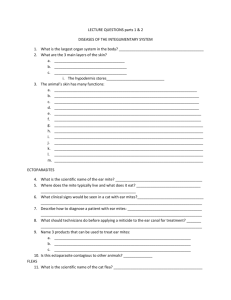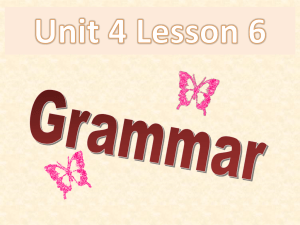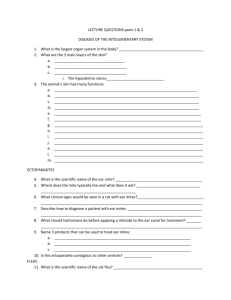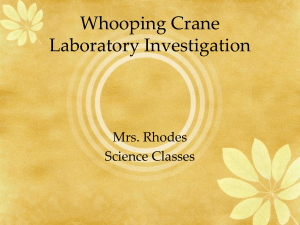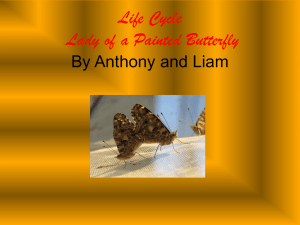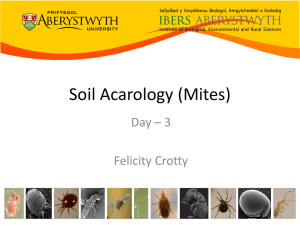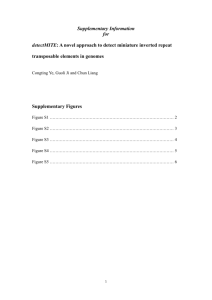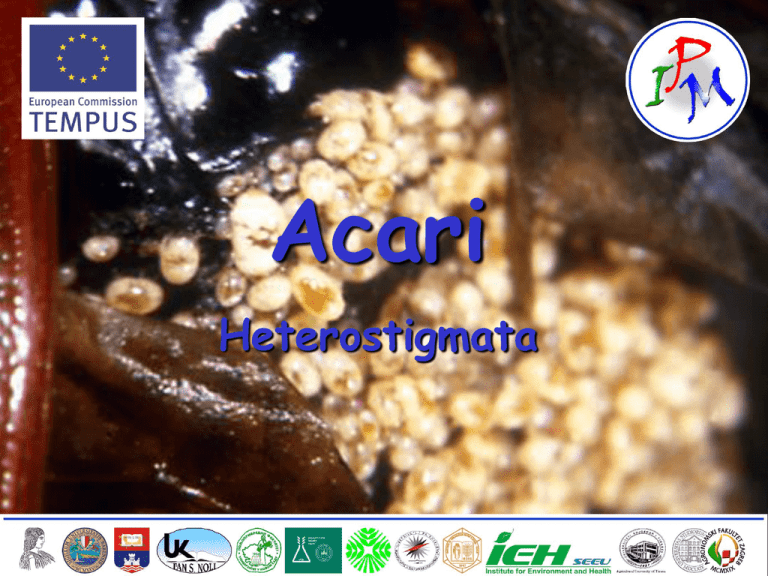
Acari
Heterostigmata
1
PROSTIGMATA
Morphological and ecological adaptations.
Chelicerae are stylet-like, hooked,
rarely chelatae; basal segments can be
sometimes fused in part or totally.
Stigmata are on the gnathosoma or
anteriorly on the propodosoma.
2
HETEROSTIGMATA
Stigmata are present only on the
female.
3
PYEMOTIDAE
Adults ~250 µm long, yellowish.
Stylet-like chelicerae.
A strong sexual dimorphism: ovigerous female
is tipically pear-shaped and swollen.
4
PYEMOTIDAE
Polymorphism (phoretic reasons) more or less evident which can be
assessed in one sex or (usually) in both sexes for some Pyemotes.
Embryonic and post-embryonic development (nymphs are absents) in
the adult female.
2-4 ♂♂ emerge at first and later ♀♀ (90% of the progeny is composed
by females) from a mated ♀; vice versa, a vergin ♀ produce only ♂♂
5
(arrhenotocky).
PYEMOTIDAE
The mites look for the host, pierce the
integument, cause the host paralysis
and a progressive digestion of the
tiessues.
Pyemotes scolyti and P. parvoscolyti
paralyze the scolityd larvae within 24
hours; P. beckeri, P. ventricosus and P.
tritici paralize the victim whitin 5
min.
Effects on the man: allergic reactions,
dermatisis, icthy, fevers, headache,
backache, asthma.
6
PYEMOTIDAE
Two days after the host infestation, the ♀ starts to swoll and become
physogastric within 2-3 days.
The ♀ starts to produce directly new individuals within 4-5 days and
it continues for about 2 weeks.
The neonate ♀♀ of some species (P. herfsi and P. scolyti) must find
an host within 2 (at 40% of R.H.) -7 (at 100% og R.H.) days.
7
PYEMOTIDAE
Pyemotes tritici and P. ventricosus are
frequent in warehouses where they prey
insect eggs, larvae and adults (Lepidoptera,
Coleoptera, Diaspids, etc.).
Characteristics:
1) high reproductive fitness,
2) short life cycle (4-7 days per generation),
3) all instars develop into a gravid ♀♀ which
do not require secondary hosts or other
food sources,
4) ♀♀ are the 98% of the population,
5) ♀♀ mate soon after the emergence and start
immediately the host search,
6) easy rearing.
8
PYEMOTIDAE
Pyemotes scolyti group
- valuable natural enemies of scolityds; phoresy on one or more
species of Scolitydae; they feed on the juveniles; insect adults are
used for dispersal.
Pyemotes ventricosus group (including P. tritici and P. ventricosus)
- non phoretic; feed on numerous hosts included adults.
Pyemotes tritici (straw- or hay-itch mite) parasitizes more than 100
species of stored grain insects (mainly Coleoptera, Hymenoptera
and Lepidoptera).
Pyemotes ventricosus is associated to xylophagous beetles or Honey
9
bees.
SITEROPTIDAE
Adults are ~250 µm long, pale yellowish.
Short and pointed chelicerae.
Strong sexual dimorphism, the gravid female is tipically pear-shaped
and physogastric.
Siteroptes graminum
Siteroptes avenae
10
SITEROPTIDAE
The ♀♀ are provided with a pair of membranaceous pockets of
integumental origin in ventral position (sporotechae).
In Siteroptes reniformis complex, the techae are
posterior to the base of leg IV.
Each techa can store 1 conidiospora of
Nigrospora sp. (specialized mutualistic symbiosis
- dissemination).
Nigrospora spp., especially N. oryzae (Berk. &
Br.), causes damages to cotton, mais, sorghum,
wheat, etc.
11
SITEROPTIDAE
In S. cerealium complex, the techae are
anterior to the leg III base.
In S. avenae, the sporotechae are about 20 μm
long and about 10 μm wide. In other species,
the techae can have a larger size also.
12
SITEROPTIDAE
These sporotechae can contain
numerous conidiosporae (up to
~12) of Fusarium spp. and Botrytis
spp.
(specialized
mutualistic
symbiosis - dissemination).
S. avenae vectors F. poae (Peck)
(causal agent of the bud rot on
carnation and silver tip of cereals)
and F. avenaceum.
Reared also on other Fusarium.
13
PYGMEPHORIDAE: Pediculaster mesembrinae
Adult ~250 µm long, yellowish with a white median and longitudinal
strip on the dorsum.
14
PYGMEPHORIDAE: Pediculaster mesembrinae
The ♂♂ have atrophic gnathosoma, legs IV modified and very
strong.
The gravid ♀♀ are physogastric, also 1 mm of diameter.
Polymorphic females are known; they are involved in phoresy.
15
PYGMEPHORIDAE: Pediculaster mesembrinae
Reproduction: egg fertilization and arrhenotocky; oviparous; ~160
eggs/♀ in 5 days.
The ♂ mates with the nymph ♀ (neotenic) of the same generation
(sexually mature).
The physogastry occurs already after 24 hours and after 48 hours
the ♀ reaches the maximum development.
Sex ratio: 100 ♀♀ to 1 ♂.
Duration of a generation:
Temperature
days
15°C
7.6
20°C
4.8
25°C
3.9
16
PYGMEPHORIDAE: Pediculaster mesembrinae
Dispersal mainly by natural passive transportation
(wind) and phoresy (sciarids strictly associated to
the fungal environment, as Lycoriella mali and other
flies).
17
PYGMEPHORIDAE: Pediculaster mesembrinae
Frequent in
greenhouses.
mushroom
Damages.
18
Fungal species
preferences°
Agaricus bisporus
--Pleurotus eryngii
--Chrysonilia sitophila
++
Cladobotryum dendroides
++
Mycogone perniciosa
+++
Trichoderma viride
+
° ability of the mite in feeding and reproducing on the
used substrate. The number of the + or – indicates the
preference degree.
Trichoderma
19
TARSONEMIDAE
About 530 species.
Mainly
with
tropical
subtropical distribution.
and
20
TARSONEMIDAE
Size: 100-300 µm long.
Shape: subcylindric.
Colour: semitranslucent and shiny,
yellow, white or pale in appearance.
Smooth integument.
21
TARSONEMIDAE
Gnathosoma is capsule-like, with short and thin cheliceral stylets,
reduced pedipalps, with 2-3 segments.
(Courtesy of A. Di Palma)
22
TARSONEMIDAE
male
♂ slightly smaller than the ♀, with
strong leg IV and genital plate or papilla
(it contains the aedeagus, accessory
genital organs).
♀ subglobose,
tread-shaped leg IV.
female
male
female
23
TARSONEMIDAE
Partenogenesis mainly for arrhenotocky.
♂ aploid and ♀ diploid.
Postembryonic development: E, L, “quiescent larva” (= pharate pupa)
and Ad.
Iponemus spp. ♀♀ have developed physogastry and lay groups of
eggs.
♀♀ deposit 1 to 5 eggs per day, with most
species producing 10 to 20 eggs in total.
Life cycle usually requires about a week.
Sex ratio: (1 male vs 3÷20 females).
No information on diapause.
24
TARSONEMIDAE
Favourable environmental conditions: high relative humidity and
temperature, scarce lighting, protected by the direct lighting.
Trophic behaviour:
• mycophagous,
• saprophagous,
• parasite (Acarapis woodi in the honey bee tracheae),
• predators,
25
TARSONEMIDAE
Trophic behaviour:
• phytophagous.
They feed on tissues with thin cell walls:
fungi and soft plant organs (buds, small
fruits, vegetative tips, etc.).
Delphinium
Symptoms: irregular development
of stems and their productions, rust.
26
TARSONEMIDAE: control
Sampling:
- symptom direct observations (distorsions)
- sampling of plants or their parts and direct
observations under microscope or mite
extraction
- random and/or localized samplings (close to
the greenhouse openings)
Control:
- taking off and destruction of infested plants as soon as they are
spotted;
- treatments of the crops by sulfur, and other aa.ii. (possibly
translaminar) against the mobile individuals;
- treatments of sapling by hot water (temperature and duration of the
application depend on the species – 43.5°C for 30 minutes against
Phytonemus pallidus) or chemicals (fumigations in cells).
27
Phytonemus pallidus (greenhouse and cyclamen pale mite)
Hosts: plants cultivated in protected and semi-protected
environments (strawberry), ornamental plants (begonia, cyclamen,
chrysanthemum, fuchsia, geranium, gerbera, petunia, Saintpaulia,
etc.).
Distribution: wide in North America, Europe, Asia.
Morphology: pinkish orange as adult; females about 250 μm long.
(from Hoy, 2011)
28
Phytonemus pallidus (greenhouses and cyclamen pale mite)
Biology:
Eggs laid (1-2 per day, 12-16 in total) in groups close to the leaf
sheaths, on young unfolding leaves.
♀♀ overwinter in group (close leaf sheaths of strawberries).
Life cycle lasts 10-14 days in optimal conditions.
Mainly disperse by stolons and infested bulbs.
29
Phytonemus pallidus (greenhouses and cyclamen pale mite)
Largest populations can be found on the vegetative
tips. It causes deformed, blistered and reduced
leaves, scanty flowering, malformed flowers and
fruits with an irregular development (for
strawberries).
The symptoms on the
leaves are increasing from the
outermost to the innermost.
30
Polyphagotarsonemus latus (broad mite, citrus silver
mite, yellow tea mite or tropical mite)
♀ amber yellowish or greenish, ~ 190 µm
long, with an indistinct white strip in the
middle of the dorsal side.
♂ lack the strip and is only about half size of
♀♀.
Egg of ~ 80 µm, with multiple parallel rows of
whitish tubercles longitudinally placed.
31
Polyphagotarsonemus latus
Polyphagous (over 100 species), indoor and
outdoor, water melon, melon, cucumber,
aubergine, pampkin, zucchini, tomato, pepper,
potato, bean, gerbera, lemon, cotton, tea, tobacco,
bean, dahlia, etc.
In Sicily it has been reported on lemon; in Lazio e
Campania it has been reported in greenhouses
(pepper, aubergine, gerbera) and in field (bean,
dahlia, potato).
Particularly active and dangerous in tropical and
subtropical environments.
Strongly sensitive at low temperature.
32
Polyphagotarsonemus latus
Eggs laid in the depressions of the lemon fruits, close to the buds
and leaf veins.
Egg-laying:
lasts 7-11 days
~ 40 eggs/♀ (2-4 eggs/day)
isolated or in small groups of 2-4 eggs
Lyfe cycle:
4-8 days at 28-30°C (70-80% di R.H.)
7-10 days at 18-20°C (70-80% di R.H.)
It tends to form small colonies.
33
Polyphagotarsonemus latus
Phoresy on tibiae and tarsi of green peach aphid (Myzus persicae),
sweet potato whitefly (Bemisia tabaci), greenhouse whitefly
(Trialuerodes vaporariorum).
34
Polyphagotarsonemus latus
Symptoms induced by injected toxins:
- on lemon, infestations on fruits can cause
suberous areas (yellowish, brownish,
silver) ± large on the fruit surface.
Possible crevices.
- stems: reduced development, malformations,
dying;
- leaves: silvering, reduced lamina, crisped lamina,
dying, phylloptosis;
- suberosis and net necrosis of the soft organs;
- flower: abortion.
35
Polyphagotarsonemus latus
On the lemon:
- It is suggested to collect 4 fruits/tree (1 for each orientation) in
the inner part (damper) of the canopy; the fruit
diameter should be <3 cm (at the highest lemon
sensitiveness). The sampling should be carried out on
the 5% of the trees.
- The infestation is generally localized, it should be avoided a
wide treatment on the whole field.
36





